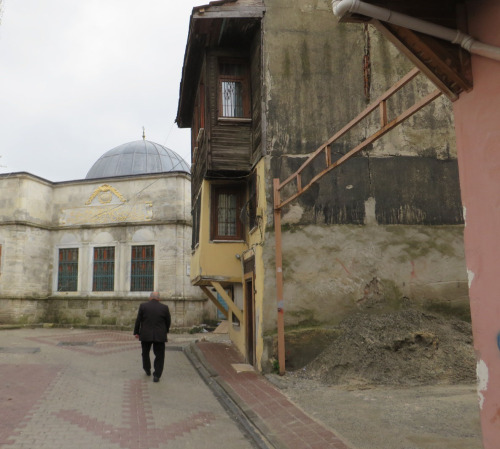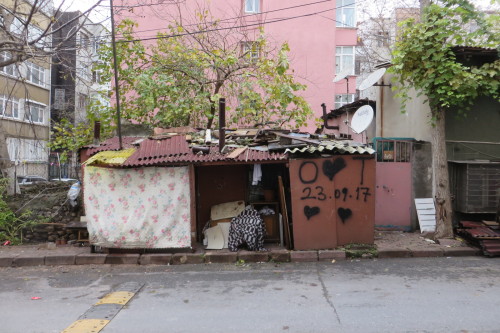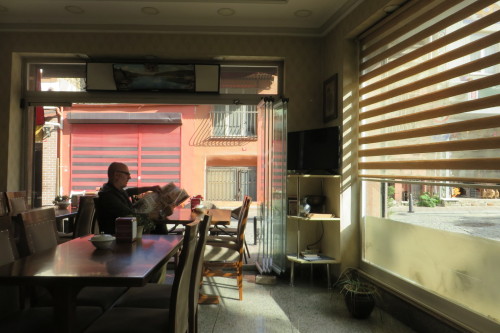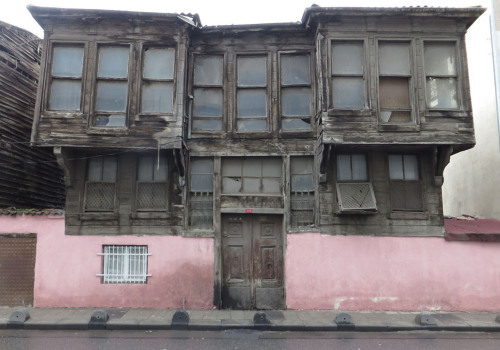
There is something delightfully disorientating in getting lost in an alien city.
This condition, whose sensations of disquiet coupled with irritation are so well described in the opening chapters of Alain Robbe-Grillet’s ‘Les Gommes’, is as close as possible to being in a dream whilst awake. There is an inexplicable sense of uncertainty, doubt, a failure to comprehend. You can see buildings, the names of the streets, but they all seem to be in the wrong place. A feeling akin to being under the influence of mind-altering drugs. Where am I? How did I get here? How do I get out? And why does this map bear absolutely no relation to reality?
To fully appreciate these feelings, you must first dispense with the deadening monotony of the smartphone and its Google maps. Instead, procure for yourself an out-dated guidebook—out-dated not by centuries (too easy), but by thirty or forty years. In a city like Istanbul, where whole town-quarters are rebuilt every decade or so, you will then have the challenge of distinguishing a shopping mall used in 1985 to locate a mosque graveyard or medieval Greek church, from one that may have cropped up five, ten or twenty years later, and which, rather than lead you to the antiquities in question, will instead keep you occupied among cell-phones, car-audio and reconditioned computers as you climb endless stairs and scour the views from terraces. What to do if the carpentry store in which the substructures of an early Christian martyrium were located in 1985 has now vanished, to be replaced by a car-wash whose entrance is at a basement level on the other side of the city-block? And which no longer affords access to the remains because they are now occupied by a restaurant and belly-dancing establishment?

And so to Aksaray. Has any place name (“The White Palace”) less in common with reality? A clover-leaf motorway intersection which uses the Italianate Valide Sultan Mosque (Pertevniyal Valide Sultan Mosque) as traffic island, so giving a whole new meaning to the term ‘spolia’. Nevertheless, as I emerge from the underpass to cross eight lanes of sclerotic lorries, past the dogs curled up in their dirt burrows, and approach a construction site resembling the aftermath of an East End blitzkrieg, I feel like Columbus slipping anchor and gliding out of Tenerife, in search of mellifluous breezes and auspicious New World driftwood. Columbus hoped to find Japan. My ambitions are more humble, if equally misguided: tracking the Byzantine sea walls among the mechanics’ shops of Kuleboyu Sokağı (Kuleboyu Street), locating the Xerolophos district and its talismanic statues, the Lycus Valley and its vanished river – in short, the topography of an invisible city. I consult the guide. “It is impossible to give precise directions for this detour, for the neighbourhood is a veritable maze of tiny gecekondus (hovels, literally shacks erected in a single night), with paths leading off in every direction.” The ‘gecekondus’ sometimes take longer to demolish than to build, but now their accumulated detritus threatens to engulf the Theodosian Walls. “The cistern is usually accessible, being used as a sort of iron shop and storage place for bedsteads.” But the cistern is now a private reception centre for wedding parties, and in place of ironmongery are pink tablecloths and Ottoman-themed attendants. When you find yourself back in more familiar surroundings, the realization sometimes creeps up gradually, or else as a sudden revelation. So when after skirting the Ördek Kasap Sokağı (Street of the Duck Butcher), those familiar concrete pylons hove into view I feel I am waking from a dream, like Alice back from beyond the looking-glass, Le Grand Meulnes from the lost estate, or Dr. Jekyl after a night as Mr. Hyde.

Extravagent metaphors come to mind when one is walking metaphysically. Petrus Gyllius saw Constantinople pinned on a map as an eagle stretching its wings and looking obliquely to the left. Today my thoughts are less heraldic. Cresting the brow of the city, heading directly east towards Seraglio Point (and Asia) from the west, I imagine the city split like cerebral hemispheres, the right sloping sharply down to the Sea of Marmara and the left to the Golden Horn, producing a potentially schizophrenic mindset for the Istanbul inhabitant. The right hemisphere, south-facing towards the light and the boundless Sea of Marmara, should tend to a sunny disposition, light-hearted, carefree and optimistic, with its antonym, doom-laden and facing north towards the murky Haliç (Golden Horn), deprived of light and space. But urbanism has a life of its own. The southern slopes, now devastated by Kennedy Boulevard, the railway and the gargangtuan Cerrahpaşa Hospital, are a gloomy place, paralysed by traffic, their small pockets of run-down timber shacks struggling for breath amongst car parks, cargo depots, and rubbish-recycling wastelands. Northwards, by contrast, the old Greek quarters (now no longer Greek) have been cocooned by the steep streets and freedom from main roads, and are now re-awakening to the comfortable rediscovery of those shock-troops of gentrification, the hipster and bohemian tourist.

Giorgio De Chirico practised metaphysical walking as a prelude to metaphysical painting. Ideal inspiration came in the Italian cities of Genova and Turin, but in a metropolis he knew hardly at all he found his first impressions produced the richest effects: “During my stay in London I lived through hours of profound metaphysical sensation, especially on Sunday afternoons when I went for walks alone, alongside the Thames, stopping by the offices of shipping companies, and so-called export-import concerns; I stopped also by shops selling canned foods, lines and equipment for deep-sea fishing. As I walked along I thought of my father, my mother, my distant childhood, of so many things which still follow me through my life with the silent beating of the wings of memory.” Zola said that a good journalist should remain in a new city up to the point that everything seems new. As soon as he starts to notice familiarities, makes comparisons with cities he knows, it’s time to move on. Even in Istanbul, the freshness lasts only two months before the stingingly new begins to fade to the familiar. You know where that enticing staircase leads, what the crumbling wall conceals. You stop taking photographs of collapsing wooden houses and “characteristic” bars. But for now I’m still absorbing the city through my pores, my follicles—all the hairs on my head, my arms, in my nose, my ears. Through the senses, obviously, but also those extra senses (sometimes termed emotions): fear, trepidation, joy—and even the silent beating of De Chirico’s wings of memory.


